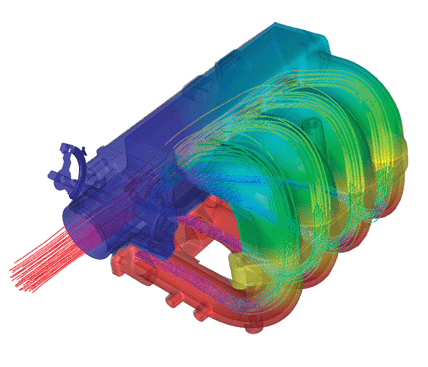Intake Systems
 The Intake system is a vital area of vehicle tuning. Original OEM systems are often designed
with a to give certain characteristics to the engine. Original systems involved just an Airfilter and a Carburetor,
and the airflow was given a short path into the engine. Changes to these systems often involved larger bodied Carbs, and cooler airflows.
As air expands with heat, hot air will be less dense. There will be less mass of air in a given volume (for example, an engine cylinder
and this will have correspondingly less Oxygen. Less Oxygen will mean less power can be produced from the burning of the fuel.
The Intake system is a vital area of vehicle tuning. Original OEM systems are often designed
with a to give certain characteristics to the engine. Original systems involved just an Airfilter and a Carburetor,
and the airflow was given a short path into the engine. Changes to these systems often involved larger bodied Carbs, and cooler airflows.
As air expands with heat, hot air will be less dense. There will be less mass of air in a given volume (for example, an engine cylinder
and this will have correspondingly less Oxygen. Less Oxygen will mean less power can be produced from the burning of the fuel.
Similar systems were used on the first Fuel Injected engines, where a simple, easy path was made from the
Airfilter to the cylinders.
Modern technology has studied the Airflow, and found certain effects can be beneficial to the power output.
A key factor in engine power outputs, is the Volumetric Efficiency (V.E) . This is the ratio of Air inside a cylinder compared to
what it can hold at atmospheric pressure. A slow turning engine, with large intake ports will have a high V.E. 100% would mean the cylinder has taken in
as much air as possible. Turbocharging can increase upon this figure by pushing more air in than it would normally hold if open to the atmosphere.
Volumetric efficiency will drop at high RPMs on Normally Aspirated (N.A) engines as they will struggle to pull in enough air in the short time
that the intake valves are open. Power is lost accordingly.
There are effects to increase the V.E on N.A engines. As with most tuning, this Intake tuning can be a compromise and only truly effective
over a certain RPM range, but picking a choosing the design to fit in around the engine, the "boost" given can be used to smooth
out the output over the engine.
Tuning can be done via the length of the intake runners, and their size. Long thin intake runners will speed up the gas velocity
and the momentum of the fast moving air will help pack the cylinder full even as the intake valve is closing. This will boost power
at lower engine speeds, but the thin runner design will restrict airflow at high speeds.
Tuning and resonance of the pipework will also help.
As the engine sucks in air, there are pulses of high and low pressure. The tuning is designed use these pulses of pressure to
get more into a cylinder, by adjusting the size and length of the intake. This effect is known as Helmholtz Resonance.
The resonance effect will only work in a given intake size as a specific RPM range, so this can either be used to remove a flat spot, add extra torque
in lower RPMs where most day to day driving occurs, or a variable length Intake system can be used to provide two resonant effects at different RPM ranges.
An example of this is the BMW DISA flap in some manifolds.
 Intake systems are frequently modified to help the engine produce more power. The first step is usually a free-flowing Air Filter, and
and Induction system. The Induction systems are designed to pull in colder air from outside of the engine bay,
which increases the air density, and therefore the amount of oxygen available.
Intake systems are frequently modified to help the engine produce more power. The first step is usually a free-flowing Air Filter, and
and Induction system. The Induction systems are designed to pull in colder air from outside of the engine bay,
which increases the air density, and therefore the amount of oxygen available.